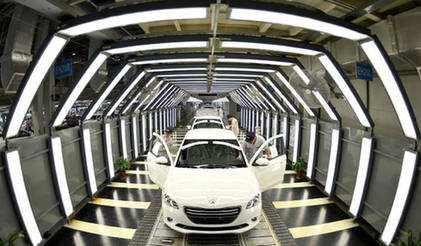Chihong’s Green Transformation Model
Meanwhile, to solve the problems of heavy metal pollution, Chihong Zn&Ge cooperated with the Institute of Geographic Sciences and Natural Resources Research under the Chinese Academy of Sciences (CAS) over development and application of soil renovation technologies. It cultivated hyperaccumulators, special plants capable of growing in soils with high concentrations of metals in mining areas to improve and restore the environment of ore bodies.
Green Upgrading
To realize transformation, Chihong Zn&Ge has carried out a series of reforms including extending the industrial chain, raising added value and developing high-end end products.
Specifically, in the processing of metal germanium, Chihong made forays into the development and manufacture of aviation solar germanium wafers and germanium components for detectors. Such ventures accelerated the diversity and technological level of Chihong’s germanium products. As for the company’s other core product, zinc, Chihong has expanded from the traditional manufacturing of zinc plate to more than 40 types of zinc alloy with higher added value. They are sold to steel companies all over China.
Chihong’s refining and smelting process produces slag, which the company recycles to extract valuable metals – gold, silver, germanium, cadmium, copper and bismuth.
Chihong Zn&Ge refines 400,000 tons of lead and zinc annually, and recycles 150 kg of gold, 180 tons of silver, 30 tons of germanium, 800 tons of cadmium, and more than 1,000 tons of other metals including bismuth and antimony. Advanced equipment, environmental responsibilities and cutting-edge technology help Chihong get ahead in the competition among domestic industrial peers.
In its strenuous energy conservation and emissions reduction efforts and maximum use of resources, Chihong Zn&Ge maintains a leading place in the sector in terms of products’ energy consumption index. In 2013, the overall energy consumption of Chihong was equivalent to 160,000 tons of standard coal, 42.9 percent lower than in 2010.
Chihong’s overall energy consumption of lead refinement from January to May 2014 was 9.5 percent below the upper level of the national standard; the consumption of zinc refinement meets the upper level of the national standard; and coke consumption in crude lead processing also leads the field.
Development of Circular Economy
Located in the Qujing Economic and Technological Development Zone, Chihong’s Qujing factory, opened in 2003, has a tranquil setting.
The key to success for a resource-based enterprise like Chihong is the circular economy development mode of resource-product-renewable resource -renewable product. This mode controls the consumption of resources and the discharge of waste to the greatest possible extent.
The enterprise also spotlights recycling of industrial waste water, slag and heat. Even sewage and rainwater are recycled in the factory.
As much as 98 percent of sulfur dioxide (SO2) produced in the refining process is recycled and re-used as sulfuric acid and ammonium sulfate. Thus, the general utilization of SO2 is as high as 99 percent. Consequently, the emission of SO2 is reduced by 50,000 tons annually, far exceeding the national environmental standard.
To recycle steam energy, Chihong Zn&Ge has installed four waste heat recovery boilers at the Qujing plant. Firstly, saturated steam is used for electricity generation; then, low-pressure steam provides heat energy for manufacturing and facilities. Such technology not only satisfies the demands of production and daily life, but also improves the utilization of heat energy and reduces energy consumption during the refining process.
The innovative rainwater recycling technology developed by Chihong Zn&Ge has been promoted among lead-zinc refining factories nationwide. The company designed three types of disposal system for industrial waste, household sewage and rainwater respectively. Rainwater is collected and reused in the production process directly after sedimentation, hence reducing the amount of water drained outside the factory and the heavy metals that may be flushed away in it. Some drainage is to be expected only in the case of heavy rainfall. Treatment of household sewage saves the company another 65,000 tons of water annually.
As for the waste materials that cannot be reused or recycled for now, Chihong Zn&Ge has invented the paste backfilling technology, whereby mine tailings are mixed with appropriate proportions of gravel and slag to fill mined-out areas.
One significant advantage of paste backfilling is its role in the prevention of environmental disasters such as subsidence, fracturing and landslides. The techniques employed at Chihong are regarded as the most advanced in backfilling technology for ore mines, and a model for mining industries globally. The case has been selected as a key demonstrational practical environmental technology project by the China Association of Environmental Protection Industry.

